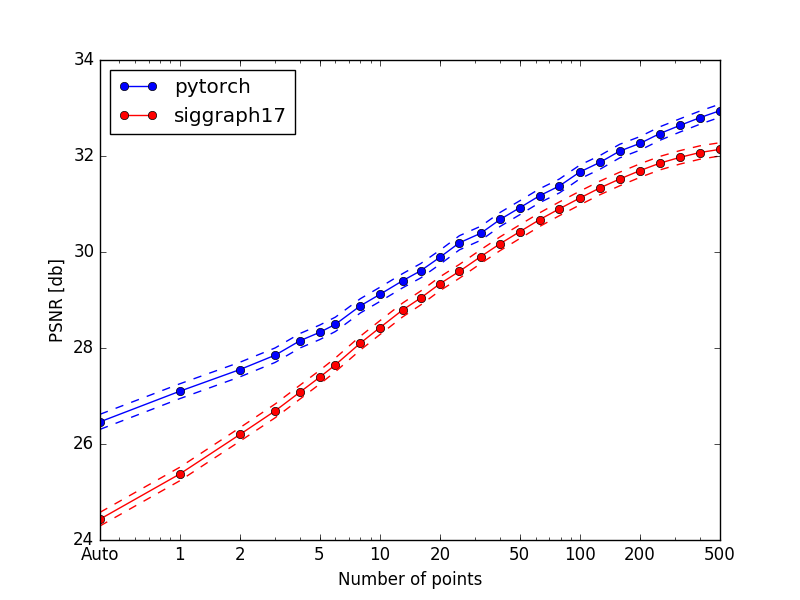richzhang / Colorization Pytorch
Programming Languages
Projects that are alternatives of or similar to Colorization Pytorch
Interactive Deep Colorization in PyTorch
Project Page | Paper | Video | Talk | UI code

Real-Time User-Guided Image Colorization with Learned Deep Priors.
Richard Zhang*, Jun-Yan Zhu*, Phillip Isola, Xinyang Geng, Angela S. Lin, Tianhe Yu, and Alexei A. Efros.
In ACM Transactions on Graphics (SIGGRAPH 2017).
This is our PyTorch reimplementation for interactive image colorization, written by Richard Zhang and Jun-Yan Zhu.
This repository contains training usage. The original, official GitHub repo (with an interactive GUI, and originally Caffe backend) is here. The official repo has been updated to support PyTorch models on the backend, which can be trained in this repository.
Prerequisites
- Linux or macOS
- Python 2 or 3
- CPU or NVIDIA GPU + CUDA CuDNN
Getting Started
Installation
- Install PyTorch 0.4+ and torchvision from http://pytorch.org and other dependencies (e.g., visdom and dominate). You can install all the dependencies by
pip install -r requirements.txt
- Clone this repo:
git clone https://github.com/richzhang/colorization-pytorch
cd colorization-pytorch
Dataset preparation
- Download the ILSVRC 2012 dataset and run the following script to prepare data
python make_ilsvrc_dataset.py --in_path /PATH/TO/ILSVRC12. This will make symlinks into the training set, and divide the ILSVRC validation set into validation and test splits for colorization.
Training interactive colorization
-
Train a model:
bash ./scripts/train_siggraph.sh. This is a 2 stage training process. First, the network is trained for automatic colorization using classification loss. Results are in./checkpoints/siggraph_class. Then, the network is fine-tuned for interactive colorization using regression loss. Final results are in./checkpoints/siggraph_reg2. -
To view training results and loss plots, run
python -m visdom.serverand click the URL http://localhost:8097. The following values are monitored:-
G_CEis a cross-entropy loss between predicted color distribution and ground truth color. -
G_entris the entropy of the predicted distribution. -
G_entr_hintis the entropy of the predicted distribution at points where a color hint is given. -
G_L1_maxis the L1 distance between the ground truth color and argmax of the predicted color distribution. -
G_L1_meanis the L1 distance between the ground truth color and mean of the predicted color distribution. -
G_L1_regis the L1 distance between the ground truth color and the predicted color. -
G_fake_realis the L1 distance between the predicted color and the ground truth color (in locations where a hint is given). -
G_fake_hintis the L1 distance between the predicted color and the input hint color (in locations where a hint is given). It's a measure of how much the network "trusts" the input hint. -
G_real_hintis the L1 distance between the ground truth color and the input hint color (in locations where a hint is given).
-
Testing interactive colorization
-
Get a model. Either:
- (1) download the pretrained model by running
bash pretrained_models/download_siggraph_model.sh, which will give you a few models.- Original caffe weights [Recommended]
./checkpoints/siggraph_caffemodel/latest_net_G.pthis the original caffemodel weights, converted to PyTorch. It is recommended. Be sure to set--mask_cent 0when running it. - Retrained model:
./checkpoints/siggraph_retrained/latest_net_G.pth. The model achieves better PSNR but performs qualitatively differently. Note that this repository is an approximate reimplementation of the siggraph paper.
- Original caffe weights [Recommended]
- (2) train your own model (as described in the section above), which will leave a model in
./checkpoints/siggraph_reg2/latest_net_G.pth
- (1) download the pretrained model by running
-
Test the model on validation data:
-
python test.py --name siggraph_caffemodel --mask_cent 0for original caffemodel weights -
python test.py --name siggraph_retrainedfor retrained weights. -
python test.py --name siggraph_reg2if you retrained your own model The test results will be saved to an HTML file in./results/[[NAME]]/latest_val/index.html. For each image in the validation set, it will test (1) automatic colorization, (2) interactive colorization with a few random hints, and (3) interactive colorization with lots of random hints.
-
-
Test the model by making PSNR vs. the number of hints plot:
python test_sweep.py --name [[NAME]]. This plot was used in Figure 6 of the paper. This test randomly reveals 6x6 color hint patches to the network and sees how accurate the colorization is with respect to the ground truth.
-
Test the model interactively with the original official repository. Follow installation instructions in that repo and run
python ideepcolor.py --backend pytorch --color_model [[PTH/TO/MODEL]] --dist_model [[PTH/TO/MODEL]].
Citation
If you use this code for your research, please cite our paper:
@article{zhang2017real,
title={Real-Time User-Guided Image Colorization with Learned Deep Priors},
author={Zhang, Richard and Zhu, Jun-Yan and Isola, Phillip and Geng, Xinyang and Lin, Angela S and Yu, Tianhe and Efros, Alexei A},
journal={ACM Transactions on Graphics (TOG)},
volume={9},
number={4},
year={2017},
publisher={ACM}
}
Acknowledgments
This code borrows heavily from the pytorch-CycleGAN repository.
